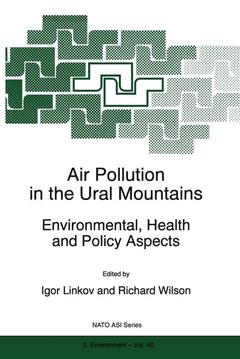Air Pollution in the Ural Mountains, Softcover reprint of the original 1st ed. 1998 Environmental, Health and Policy Aspects NATO Science Partnership Subseries: 2 Series, Vol. 40
Langue : Anglais
Coordonnateurs : Linkov Igor, Wilson R.

Mankind has created pollution, and has suffered its consequences since time immemorial. This has intesified greatly since the industrial revolution. One of the main problems in society, and a major function of government is how to cope with this pollution. 80 years ago the maxim used to be "the solution to pollution is dilution"; to dilute any pollted water supply in a large river, or to build a tall chimney stack to dilute air pollutants into the air so that concentrations of pollutants are always low. Since 1950 western countries have gone further and made major attempts to reduce the emissions of the most important pollutants. The discussion of what is an important pollutant has changed. To S02 and heavy metals such as cadmium or arsenic we now add fine particles and even (when we discuss global climate change) C02. The experience and practice of the western countries was only partly followed in the USSR (although the switch from use of coal to natural gas in major cities around 1970 was very important). Since the collapse of the USSR it has become fashionable both in the west and inside Russia to blame all society's ills on pollution. The statistics do not bear out that conclusion, but pollution remains an important issue which can be reduced without significant detriment to other societal values.
Introduction: Particulate Air Pollution; R. Wilson. Mining and Environment in the Urals During the 18th and 19th Centuries; J.O. Nriagu. Part 1: Environmental Contamination in the Ural Mountains: Measurements, Methods and Models. Analysis of the Environmental Situation in the Ural Economic Region; V.N. Chukanov, B.A. Korobitsin. Pollution Stress to Siberian Forests; S. Nilsson, et al. Dry Deposition of Particles from the Atmosphere; M.J. Zufall, C.I. Davidson. Russian Regulatory Diffusion Models: Status, Results of Validation and International Intercomparisons; E.L. Genikhovich. Numerical Simulation Models for Airborne Heavy Metals in Europe: A Review; G. Petersen. Measurements and Models for Trace Element Input and Time Distribution Recorded in Forest Soil and Bog Ecosystems; W.R. Schell, et al. The Use of Portable Instrumentation for Assessing Environmental Contamination in the Urals Region of Russia; T.M. Spittler. Use of Small Mammals for Monitoring Heavy Metal Contamination in the Environment; K. Sawicka-Kapusta, M. Zakrzewska. Influence of Air Pollutants in the 7Be Size Distribution of Atmospheric Aerosols; C. Papastefanou, A. Ioannidou. Environmental Conditions in the Areas Exposed to Emission from the Gas Processing Industry in South Ural; A.Z. Kaliyev. Study of the Environmental Contamination in the Major Industrial Areas of the Urals with Focus on Remediation of Human Health Problems (Report of the Working Group on Environmental Contaminants); T.C. Hutchinson, M.S. Symington. Part 2: Health Consequences of Air Pollution. Assessment and Comparative Analysis of Health Risks Caused by Air Pollution in Cities of Russia; B.A. Revich, A.A. Bykov. Lead Contamination of Russian Cities: Assessment of Risk to Children's Health; A.A. Bykov, B.A. Revich. Evaluation of Existing Environmental Information Systems in Russia Applicable for Human Health Effects Assessment; H. Özkaynak, et al. Existing Health Information Systems in the Russian Federation and their Use in the Assessment of Environmental Health Effects; J.J.K. Jaakkola, et al. Assessing Chronic Health Risks from Stationary Source Air Emissions in Volgograd, Russia; B. Filatov, et al. Public Health Trends in a Transitional Russian City (1959&endash;1994); G.I. Chechenin, et al. Contemporary Problems of Ecopathology and Evaluation of Health Risk in Management of Environmental Quality in the Ural Region; V.S. Koshkina. Evaluation of Ecological Pathology for the Tasks of Monitoring and Nature Protection Management; N.V. Zaitzeva, et al. Ecopathology of Mercury Pollution; L.M. Karamova, R.A. Alakayeva. Perspectives on United States Methods of Human and Environmental Risk Assessment; J.C. Willson. Prioritizing Environmental Activities in Nizhnii Tagil Based on the Assessment of Human Health Risks Due to Air Contamination; P.S. Zhilin, I.D. Kopylov. Health Effects Associated with Air Pollution in the Ural Mountains (Report of the Working Group on Health Effects); J.O. Nriagu, J.G. Wilkinson. Part 3: Air Pollution and Environmental Policies. The Role of Economic Valuation in Decision Making About Air Pollution; A. Markandya, I. Milborrow. Optimal Control Applied to Air Pollution; B. Morel. Uncertainty Assessment of Biogenic Emissions Estimates and its Impact on Ozone Attainment Control Strategy Selection; J.G. Wilkinson. Air Pollution Space-Time Analysis; F. Ferreira, et al. Automated Information System for Decision Making Support
The metals industry was established in the Ural Mountains over two centuries ago. Seventy years ago, the town of Magnitogorsk was established, with US and Western assistance, to exploit the iron ore there. It became a symbol of USSR industry -- and is now a symbol of air pollution. This volume describes the pollution in the region and the steps being taken to combat it.
Date de parution : 12-2012
Ouvrage de 455 p.
16x24 cm
Thèmes d’Air Pollution in the Ural Mountains :
© 2024 LAVOISIER S.A.S.



